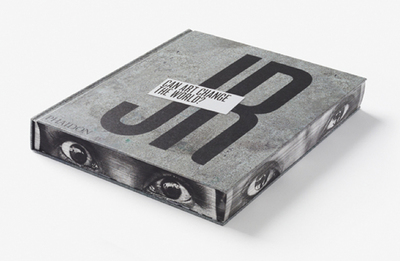Can Art Change the World?
A standard 28mm lens gives photographers lots of light and a huge depth of field to play with. But it also forces the artist to get close—intimate, even—with his or her subject. So it’s not surprising it’s the lens of choice for JR, the French street artist whose work, if not his name, has become familiar to anyone who drove by the signature tower of Boston’s skyline this past fall.
JR is best known for his portraits of people that reveal emotion through facial expressions, which are then blown up and plastered on walls and buildings throughout the world. JR, whose true identity is shrouded in mystery, was behind the massive mural that started taking shape on the western face of the former John Hancock Tower in late September.
When it was completed, the mural measured 150 feet wide and stretched from the 44th to 50th floors of the building, which is now called 200 Clarendon. Like most of his work, the photo itself was of an anonymous person in an anonymous place; the one in Boston appeared to be a shirtless man walking on a strip of beach and was selected, the artist said, to take advantage of the building’s blue, water-like glass facade and the surrounding skyline.
Now comes Can Art Change the World? ($59.95, Phaidon), the first major retrospective for the artist who has been called “the French Banksy”—somewhat unfairly, given that JR has emerged as a unique voice in the world of street art and the moniker implies that he’s simply a knock-off version of the British artist. Given the political nature of his work, the book suggests that Boston, relatively speaking, was a tame locale for JR. This was, after all, the artist who plastered massive portraits of smiling Israelis and Palestinians side-by-side on both side of the Separation Wall in 2006 and documented North Korea’s celebration of Kim Il Sung’s 100th birthday on Instagram in 2012.
The book was produced with cooperation from the photographer, and Nato Thompson captures the artist’s philosophy when he quotes JR in his introduction: “Images are not special. It is what you do with them.” In this respect, Can Art Change the World? is as much about JR’s process as it is about his art. A graphic novel that serves as a foreword shows how he started out as a 13-year-old graffiti artist, then graduated to photography after finding an abandoned camera in a Paris Metro station. There is a full-page photo of dozens of rolled-up prints that will serve as pieces of one of JR’s murals stacked neatly in the open hatchback of a compact car. There is a progression through the book, starting when the young artist used a reversible jacket to quickly change his appearance and avoid detection while setting up one of his installations, to more recently, when building owners and cities such as Boston clamor to wear his artwork like a badge of hipness.
Can Art Change the World? also reveals the patterns of JR’s work, which may not be familiar to people who have only seen the Boston installation. JR is at his best when he’s working close up, catching the depth and emotion within his subject’s eyes (in a clever design touch, a set of eyes stare out from the fore edge of the book). What might be most remarkable about his work is his ability to capture ordinary people through careful documentation of details and then blow them up to extraordinary proportions. Simultaneously, he forces us to put aside assumptions of the people he shoots; one of his most famous photographs, at first glance, appears to be a young black man pointing a gun at the photographer in a downtrodden suburb of Paris. Only upon closer inspection do we see that he is holding a camcorder.
There is no substitute for seeing JR’s work in person, and those of us who saw the Hancock installation can count ourselves among the lucky. Yet the book does come close to capturing the mystery one feels when seeing his work for the first time. It’s the focus on process and the context surrounding each installation that mark the ambitious book’s success in capturing the essence of JR’s work.
Dave Copeland is a writer who lives in Reading, MA. He teaches at Bridgewater State University and Bentley University.




